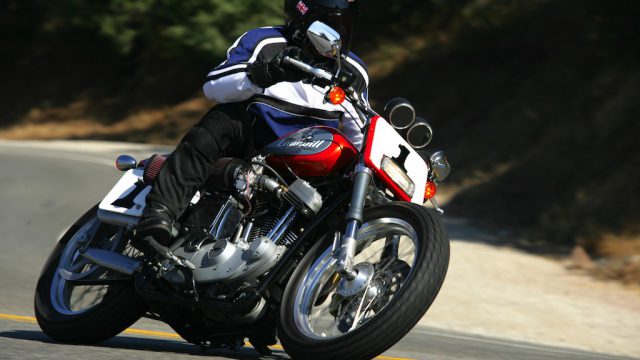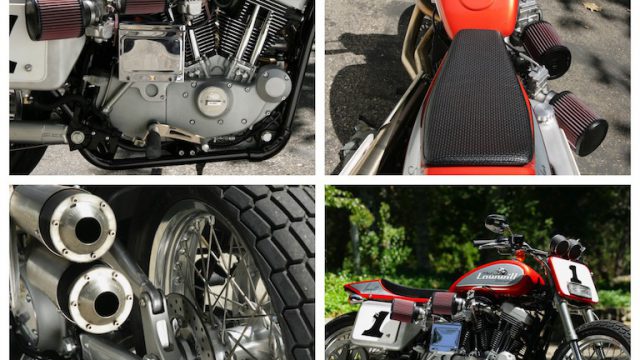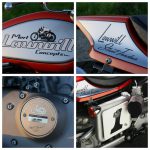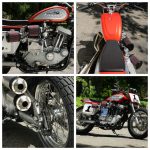Private test on Californian roads of the most authentic streetbike tribute to Harley-Davidson’s four decades of dirt track dominance that money can buy
Harley-Davidson bosses had to have their corporate arms twisted by H-D Europe to produce the XR1200, as an overdue tarmac tribute to the dirt-track dominance of the iconic XR750 flat-tracker introduced back in 1972, and still winning AFT National races in 2017. But when it finally reached production in 2008 after being unveiled at the 2006 Intermot show in Germany, it was for European customers only. Yanks need not apply – well, not for another year till it finally reached US showrooms, only to be discontinued in 2012.

But at the end of the day, the XR1200 was still a modified Sportster made over to resemble an XR750 at first glance, with a powerplant delivering around 20 bhp more than the XL1200 motor it was derived from. But its porky 250kg/550lb dry weight that came via its stock Sportster frame, certainly impacted on performance – plus the XR750’s key visual design cue of a pair of carbs parked on the right of the motor, wrapped with air cleaners to keep out the dirt, was missing on that fuel-injected streetbike, breathing through a central airbox. And the stacked exhausts were on the wrong side, too. As a racer with lights, it was about as close to an XR750 as a crossplane crank Yamaha R1 is to Valentino Rossi’s YZR-M1 MotoGP bike – which is to say, still fun to ride, but by no means the Real Thing….
Just 20 bikes like this were built between 2006 and 2015, but Lawwill is still prepared to build another provided the customer furnishes his own pre-2005 non-fuel injected 1200 Sportster
That’s where Mert Lawwill came in – and if you have to ask “Mert who?”, then you’ve never seen the best bike movie of all time, the recently deceased Bruce Brown’s On Any Sunday, and don’t have a handle on AMA Grand National racing heritage. For Lawwill, 77, was AMA champion in 1969, the year before the movie was shot which chronicled Mert’s bid to defend his title a year later. By the time Lawwill hung up his racing leathers in 1977, he’d amassed a total of 161 AMA Grand National race finishes during a 15-year pro racing career, including 15 race wins in each of the series disciplines (TT, Mile, Half Mile, Quarter Mile) except road racing, where he finished second in the 1965 Daytona 200. Mert became one of the top U.S. designers of motorcycle race chassis, before turning his expertise to the rapidly growing world of Mountain Bikes, developing a revolutionary bicycle rear suspension system which took the cycle industry by storm. Lawwill's offoad pedal-racing products became much prized by top riders around the world, and his Mountain Bike designs won numerous National and World titles, making him the only man to enter both Motorcycle and Mountain Bike Halls of Fame. And then, his wide-ranging talents led him to develop a prosthetic device that bolts on to the handlebar of any bike, with or without an engine, to enable amputees to get back in the saddle again, followed by a shock for the prosthetic hand which enables the user to handle violent impacts better. There’s also a prosthetic elbow for above-elbow amputees, and around one third of all the prosthetic hands he manufactures go to military veterans of the Iraq and Afghanistan wars.

Finally, though, Mert Lawwill turned his attention to building a streetbike – not just for himself, but one customers could buy, too. “People had been after me for almost 10 years to build a Street Tracker, a motorcycle that looked exactly like a dirt-track racer, but was street-legal enough that you can ride through town on it,” says Mert. “For many years I didn’t believe there was a big enough market to support that, until finally back in 2005 I started to think – hey, it’s time, the window’s open. So I started developing the Lawwill Harley Street Tracker, and I’ve made 20 of them since then based on brand new XL1200 Sportsters. The price started out at $29,900, but gradually went up to $34,000 complete because of all the labour involved. But then Harley fuel-injected the Sportster for ’07, so now a customer has to supply a pre-2007 Sportster as a donor bike, in which case I can build them a Street Tracker out of that for less money, and they’ll have all the stock parts left over they can sell on eBay.”

If ever a naked-but-unashamed streetbike had presence, it was this first-ever faithful replica of an XR750 flat-tracker to come with a VIN no. on the frame. That’s instead of hanging lights and a horn on a retired racebike and hoping the cops won’t notice you thundering along Racer Road, or producing a sort-of visual tribute to all Harley’s dirt oval yesterdays – like the factory-built XR1200, or any of the Sportster-based specials produced by aftermarket firms.
Re-engineered rubber-mounted XL1200 Sportster engine has all-new cylinder heads allowing twin Mikuni flatslide carbs with K&N air filters to be hung on right side for correct flat-track appearance, unlike factory XR1200
To create a Street Tracker in the spacious workshop latched on to his Tiburon home on the scenic shores of San Francisco Bay – a stone’s throw from the legendary Mount Tamalpais, where he developed his leading edge Mountain Bikes – Lawwill took a carburetted XL1200 Harley Sportster with rubber-mounted Evolution motor, stripped out the engine, handlebars, wiring loom and turn signals, detached the VIN plate from the stock frame, removed the cylinder heads – and then he was ready to start producing a streetlegal special with an original Harley VIN number, for ease of registration, post-construction.

The Street Tracker’s air-cooled pushrod V-twin motor retained the stock XL1000 Sportster’s 88.8 x 96.8 mm longstroke dimensions, but used special new heads cast by STD in Los Angeles, which swapped everything over to place the exhaust ports on the left side and the intake on the right, to mimic the XR750 flat tracker. “I had to modify the street engine so that not only in appearance did it seem to be a dirt tracker, but so that it performed like one, too,” says Lawwill, whose reworked heads carried twin 38mm Mikuni flatslides, both now on the ‘proper’ right side, and each wearing a hefty K&N air filter. The relocated intake ports were now elevated to give dramatically better flow into the combustion chamber, which together with specially designed Andrews cams allowed the Street Tracker to deliver 92 bhp at the rear wheel at 6,000 rpm, with 115Nm/85ft-lb of torque. An H-D Screaming Eagle full race ignition system, and SuperTrapp stainless steel exhaust system were installed. “It was a 1200, so you didn’t have to lean on it too hard to get quite a bit of horsepower,” says Mert, although producing that much from a motor starting out with around 65 bhp, didn’t happen overnight. The stock XL pistons were flycut for clearance, and the special two-valve cylinder heads had larger 1.875in intake valves but the same 1.60in exhausts, albeit with those completely reshaped ports. But stock XL1200 pushrods and hydraulic lifters still live in the engine, so today the Street Tracker motor runs quieter than most race bikes, and is as relatively maintenance-free as a stock Sportster. Lawwill also retained the standard five-speed Sportster transmission, with triplex chain primary and belt final drive.
Lightweight chrome-moly frame steers well, reduces weight by 100lb/45kg over stock Sportster, is stopped by 292mm Brembo discs – one at each end
The Street Tracker’s lightweight 4130 chrome-moly steel twin-loop frame and aluminium oil-tank were built by one of Mert’s former race mechanics, Jim Belland, at his shop in aptly named Cool, California. This housed the dry sump V-twin engine via the same rubber mounting lugs as the stock Sportster, with 43mm upside-down Showa forks sourced from a Buell Firebolt mounted at a 27° rake via the A&A custom triple-clamps delivering 99mm of trail, but just a single Brembo front disc with four-pot caliper – although the mounting lug was left on the other fork leg to allow doubling-up on stopping power later on. 19-inch flat-track style Kosman wire wheels with Excel aluminium rims carried Maxxis dirt track tyres with a special paved oval compound ideal for the highway, and the 3.5-US gallon aluminium gas tank was finished in a fetching shade of tangerine on all Street Trackers. The aftermarket lights included a small square headlamp that got you home at night if needed, subtly slotted into the big oblong No.1 raceplate to retain The Look. The race plate is actually the oil tank for the dry sump motor, which had to be relocated owing to shock placement. All the various brackets and plates needed to complete the bike were CNC-machined by Dave Garoutte at DKG in San Rafael, Ca. DKG also helped create the Street Tracker’s unique Lawwill-patented Quadrilateral rear suspension system, which is a development of the system Mert developed so successfully for his Mountain Bikes, duly commercialised on the Fischer RS-1 sportbike, after realising that a lot of rider effort was being wasted on a conventional rear suspension system, in compressing the shock while pedalling.

“In the late 1980s I was riding my original Pro-Cruiser Mountain Bike with a rigid frame up on Mount Tam, and I came straight down the mountain at about 20mph – full white-knuckles death grip, sure I was going to die!” recalls Mert with a grin. “And then I thought – hey, wait a minute, if I was on my motorcycle, I’d come down here twice as fast, and wouldn’t even think about it. So I realised, click – you gotta have suspension. This had been done for a few years already on bicycles, but had always been a disaster for two reasons – number one it added a lot of weight, but mainly the problem was it consumed pedal energy. So I thought – how can I design a system where you can pedal, but it won’t drain the energy, and you still have suspension? That’s how I wound up with the Mountain Bike frame designs I did, which each had two swingarms, one above the other. Being the power source, the chain was located above the lower arm, so any energy you put into the lower arm would tend to pull it up, the opposite of a motorcycle when you get on the throttle, when it tends to squat down and then drive. Well, I knew that wastes energy in your leg – so next I put the upper arm in, so now the opposite is happening. Now the chain is below the upper arm, so it’s going to pull that arm down and the lower arm up – they’re both tied together, so you can’t pull either just on its own, meaning they cancel each other out, and all the energy you produce goes into forward motion. So I figured, let’s try that out on the Street Tracker, where I’ve gone a step further, and located the four pivots in such a manner that it keeps the wheelbase constant relative to the countershaft sprocket – it’s the same throughout its wheel travel, which was always a problem with a Harley. So now you have constant final drive tension – no matter where the wheel is in its rotation, the belt tension on the Street Tracker is still the same.”
Lawwill’s unique, patented, twin-swingarm Quadrilateral rear suspension provides excellent grip, good compliance and high ride quality – worth looking at for Superbike application
So the two swingarms mounted on the Street Tracker were connected at the rear via a vertical link, while the specially-made fully-adjustable Penske monoshock only connected the twin swingarms, and didn’t actually attach to the chassis in any way, with provision for changing the ride height via a separate adjustment on the lower swingarm. “Penske designed and valved a special shock that works for the kind of energy that this system uses,” says Lawwill. “The shock damping had to be considerably different, because the motorcycle no longer compresses the rear suspension – in fact, it does the opposite. So, when you touch the throttle the motorcycle rises, much like a dragster or any dirt track race car does – it’ll rise and deliver the weight transfer that way, and then accelerate ahead. So the valving is almost opposite to what it is on a typical dirt track shock absorber.” Another key benefit of the system is that the rear suspension remains unaffected by throttle operation – the fact that cracking the gas wide open on the Lawwill layout doesn’t compress the rear shock, as otherwise happens on a conventional layout, means you can choose softer, more compliant suspension settings, without any risk of bottoming out the shock. This is especially useful with an engine as torquey as a V-twin Harley, where you often have to fit an unduly stiff spring to counter the effects of all that torque under acceleration, which negatively impacts compliance, control and comfort.

But for power-hungry Superbikers, the best is yet to come. “I built this system in the beginning to conserve rider energy on a bicycle,” says Lawwill. “It also therefore conserves horsepower on the motorcycle, the reason being that the power is moved directly into forward motion, and in the case of a dyno test, it’s going into delivering power directly to the rear wheel, rather than losing some in compressing the shock absorber spring. If you can imagine riding along a straight with the throttle wide open, the chain will be taut, which means you’re wasting energy by keeping the suspension compressed when you don’t need to. So we discovered by putting an XR750 motor on the engine dyno that it was giving out around 96-97 horsepower there – but then we put it in this chassis, and stuck it on a separate rear wheel dyno, and now we’re up to over 100 rear wheel bhp! We actually got more horsepower at the rear wheel rather than less, since the energy was going to the dyno rather than compressing the spring. It’s true rear wheel performance – no power losses driving the shock!”

Hmm, sounds too good to be true – so let’s head off for the hills to see for ourselves. First off – no two ways about it: this is not a comfortable bike to sit on, because the Street Tracker’s riding position prevents you putting both feet on the ground at a stop light, thanks to the carburettors hanging in the breeze on the right, and the only slightly less obtrusive stacked exhausts on the left. Ergonometrically speaking, this bike is very awkward to ride at low speeds or in town. However, that’s not where or how it was designed to be ridden. So fire up the motor, listen to the glorious sound of thunder emanating from the twin stacked SuperTrapp exhausts, blip the throttle to keep it running – as you must, since the Street Tracker absolutely will not idle – relish the distinctive twitter from the throttles each time you twist your wrist, stab the street-pattern gear-lever into bottom gear, crank up the revs, and head out of town to the twisties. A treat lies in store.

At lower revs the Lawwill H-D is reasonably tractable, content to lope along in traffic off the cam without complaint, just as long as you keep the motor turning above 2,000 rpm, else it’ll stutter and snatch the transmission. But when the road opens up and you can get ‘er revving, the Street Tracker chameleon changes colour. Just as the needle on the tacho hits the 4,000 rpm mark, there’s a glorious surge of power that’ll swiftly have you practising your dirt-track technique on tarmac, as you use the wide handlebar to countersteer, and catch the rear Maxxis tyre as it starts to slide. Get the wheels in line, and the Lawwill Harley launches itself forward in an incredibly muscular, meaty way, accompanied by a vivid roar from the twin pipes. You can’t fail but get a big buzz of exhilaration as it thunders forwards – but at a little over 6000 revs, it’s all done, and you have to grab another gear in pursuit of more of that magical high end grunt. And as the Street Tracker accelerates, you’re suddenly aware that it’s actually rising slightly on the rear suspension as it does so, not squatting down to hunker along hard as most other bikes do, thanks to the unique Lawwill Quadrilateral rear end. What’s more, running over bumps while accelerating hard leaned over, doesn’t get the rear wheel chattering or the bike skipping around, as on most other motorcycles with this much muscle. You can feel road shock through the forks, but it remarkably doesn’t impact the rear wheel anything like as much – this just follows the road surface very compliantly, and the ride quality is high for a hard-assed hotrod like this one.

The Brembo brakes stop the Street Tracker well, though it pays to use the rear one quite hard to help the same-size single front disc haul down a 450-pound motorcycle – 100lb lighter than a stock Sportster! – from terminal velocity. Doing that on most Big Twins would be a recipe for chattering the back tyre into turns, but not here. For not only does the Lawwill Quadrilateral rear end effectively eliminate time-wasting wheelies, but it also separates the dynamics of braking from suspension movement. That’s because the rear brake is floating, and the torque arm runs from the floating brake to the frame, directing the energy there, rather than to the rear wheel. This means you use the rear brake harder than on other bikes, so Lawwill could get away with using just that single front disc and the consequent benefit of a reduction in gyroscopic mass, which makes the steering faster, easier and more precise than with a twin-disc set-up. That’s also a factor in countering the heavier steering imposed by using the wide front Maxxis dirt-track tyre – the result is a score-draw, with extra grip from the fatter tyre, yet sharper steering from the Lawwill custom frame.
Exhilarating performance offsets uncomfortable riding position for street use on true racer with lights
The Street Tracker handles well on the hard stuff, and it’s agile in turns thanks to the wide handlebar, with good feedback over all surfaces thanks to the Showa fork that works as well as on the Buell it’s sourced from, and the soft rear suspension settings permitted by the special rear end. Only thing I didn’t care for was the lack of stability at speed, where at anything over 70 mph or so the bike would start to weave slowly but deliberately in a straight line. Call it a shimmy rather than a shake, but it’s a spinoff from using the dirt-track tyres. If you don’t want as authentic a look, use regular Dunlop street tyres, and the problem goes away.

Mert Lawwill’s 20-bike tribute to Harley-Davidson’s decades of dirt-track dominance, a glorious history in which he played an honourable role, is indeed an authentic, well-performing motorcycle. But the dynamic benefits of its patented Quadrilateral rear end are certainly strong enough to merit attention from manufacturers of modern sportbikes looking to tame their 200-plus horsepower packages.














Where can I get my xr1200r motors rear head flipped like that , met Mert in vegas when he 1st started his schwinn straight 6 suspension thanks jeff 310-663-6877